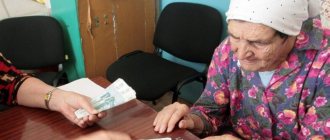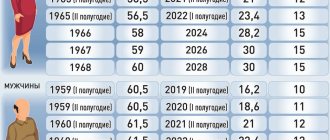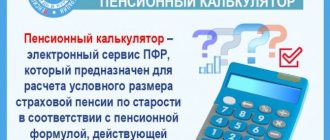Conditions for increasing pensions for Soviet service
The period of labor activity of a citizen participating in the compulsory pension insurance system is conditionally divided into several segments:
- up to 1990 (inclusive);
- from 1991 to 2001 (inclusive);
- from 2002 to 2014 (inclusive);
- since 2015
The period up to and including December 31, 2001 is conditionally counted as Soviet service. When assigning a pension, all the time during which a person worked is taken into account. The pensioner’s payment file may not contain documentary evidence of work for this period, since centralized personalized records began to be kept only in 2002.
Recipients of old-age or disability pensions may apply for a recalculation of their pension taking into account Soviet service.
The citizen must personally submit an application to the Pension Fund and confirm the work periods by providing the documentation missing in the payment file. He is required to recalculate his pension upward, taking into account:
- labor activity until 2002;
- preferential length of service during the USSR;
- non-insurance periods.
When taking into account Soviet service for recalculating pensions, the Pension Fund employee takes into account the periods:
- employment as an employee or worker;
- the work of evacuated citizens on collective farms during the Great Patriotic War (WWII);
- individual labor activity;
- creative activities (cinematography, fine arts, literature);
- work as the chairman of a collective farm or his deputy on the direction of Soviet or party bodies;
- activities as a member of the fishing cooperative artel;
- work as a labor obligation;
- employment by members of collective farms and other cooperative organizations;
- service in paramilitary security, special communications agencies or in a mine rescue unit;
- other work if the person made contributions to state social insurance.
Periods of temporary disability, studies in secondary specialized and higher educational institutions, service in the armed forces and other law enforcement agencies, as well as stay in partisan detachments and in captivity are counted into the Soviet work experience for subsequent recalculation.
The total length of service includes the time spent actually caring for a group I disabled person who has become incapacitated due to a military injury.
The pension for length of service in Soviet times can be increased by including periods that during the USSR were included in preferential length of service. For recalculation, the following work is taken into account:
- with harmful, dangerous and difficult working conditions (Lists 1 and 2);
- in elected positions in Komsomol and party organs, political departments and directorates;
- on water transport;
- in the regions of the Far North (RKS) and in equal territories (TKS);
- in leprosy and anti-plague institutions.
We suggest you read: How to calculate alimony from a non-working person
The time before retirement, when a citizen did not work or could not work due to objective circumstances, refers to the so-called “non-insurance periods”. For each full year, the applicant is entitled to a recalculation in the form of 1.8 PB:
- caring for a disabled person of group 1 and a disabled child;
- criminal punishment if the person was later rehabilitated;
- service in the army as a conscript soldier;
- receiving unemployment benefits;
- staying with a diplomatic spouse on the territory of another state (maximum duration – 5 years);
- moving to another area with a military spouse in the absence of the opportunity to get a job in the specialty;
- care for elderly people over 80 years of age.
Recalculation when caring for a child from birth to 1.5 years occurs taking into account the order of birth of the baby:
- for the first – 1.8 PB per year;
- the second – 3.6 PB per year;
- third and fourth - 5.4 PB per year.
The maximum duration of child care time taken into account in the length of service is limited to 6 years - one and a half years for each child. The maximum possible number of PBs is 24.3. For confirmation, you must provide birth certificates of children.
What changed in pension legislation later?
No matter how much citizens want stability, the state is always looking for ways to improve the existing state of affairs. In theory, it concerns improvement, although in practice this does not always work out.
The year 2015 brought news to pension legislation, and the valorization of pensions was not specified in federal laws. The issue of increasing pension savings earned in the labor spaces of the Soviet period has become quite acute. Does it mean that, according to the updated Pension legislation, the absence of mention of the valorization of pensions will mean the termination of the process?
In this case, the insurance part of the pension capital is taken into account. Pensioners who have newly registered and received this social category, who were engaged in labor activity before the beginning of 2002, reserve the right to indexation (valorization) of their pension.
Trying to make pension calculations as transparent as possible, the state invites everyone to check the state of their future using calculators on the official website of government agencies or use pension calculation formulas from legislative acts.
The concept of coefficient based on experience and earnings
The length of service is used when calculating pensions for the period before 2002 and is an indicator of the employee’s total length of service. The earnings coefficient is an individual indicator of a citizen, determined for a month out of any 60 consecutive months within 10 years of service.
In this case, breaks are not taken into account. To do this, it is necessary to divide the salary amount accepted for calculating the pension by the average monthly earnings.
What is the experience coefficient?
Valorization
This is a recalculation of old-age payments for the Soviet period. It affected all senior citizens – those with mixed experience and those who are already pensioners. At the same time, all of them automatically receive an increase of 10%, and for those who have experience before 1991, 1% for each year.
Since 2001, pension payments have increased by 352 rubles and by the beginning of 2002 its average amount was 1,600 rubles.
Converting work experience into pension points
Number of pension points = amount of pension capital / cost of 1 PB (as of January 1, 2015).
In order to determine the amount of pension capital used for recalculation, it is necessary to make a series of calculations: in compliance with the following algorithm:
- Determine the experience coefficient (SC).
- Calculate the average monthly earnings coefficient (AMC).
- Calculate the amount of the estimated pension (RP).
- Carry out valorization.
- Apply a correction factor taking into account the indexations made.
We suggest you read: Worked without a contract, didn’t get paid, what to do
The value of the SC depends on the number of years of Soviet service. For men who have worked less than 25 years and women whose work experience does not exceed 20 years, the SC is 0.55. For each additional year above the established value, the applicant is entitled to an increase of 0.01.
Please note that the law limits the maximum value of the SK. Regardless of gender, length of service and nature of activity, it cannot exceed 0.75.
Example:
- The man has an official work experience of 16 years. Its SC will be 0.55.
- The woman worked for 23 years. Its SC is 0.58 (0.55 0.01 x 3 = 0.58).
- The woman’s work experience is 42 years. SC will be equal to 0.75. (0.55 0.01 x 22 = 0.77, which is more than the legally established indicator).
To determine the SSC, it is necessary to have data for any 60 months of employment. Having determined the average monthly income, the resulting value must be divided by the average salary for 2001–2002. in Russia (1,494.5 rubles). Regardless of the result obtained, the maximum ratio value is limited to 1.2. The exception is citizens who have experience in the RKS and PKS. Their KSZ varies from 1.4 to 1.9.
Example:
- The average citizen’s earnings for the selected period of employment was 1,600 rubles. KSZ = 1.07 (1,600 / 1,494.5 = 1.07).
- The average salary of the applicant for the selected time is 2,100 rubles. The KSZ will be 1.2 (2,100 / 1,454.5 = 1.4, which is higher than the legally established value).
- The average salary of a citizen with northern experience was 2,600 rubles. KSZ = 1.7 (2,8600 / 1,494.5 = 1.7).
RP = SK x KSZ x 1,671 – 450, where:
- 1,671 – average salary in the country for December 2001;
- 450 is the basic pension amount, which is determined by the law on labor pensions No. 173-FZ (12/17/2001).
The value (SC x KSZ x 1,671) cannot be less than 660. If during the calculation the amount received is lower, the value of the RP is determined at the minimum level - 210 rubles.
RP = (SK x KSZ x 1,671 – 450) x St, where:
- ST for women = length of service before 2002, divided by 20;
- St. for men = length of service until 2002, divided by 25.
We invite you to read: Dismissal due to staff reduction - step-by-step instructions, sample order
Important: if (SC x KSZ x 1,671) is less than 660, the value of 210 rubles is used in the calculation.
Example:
- A man has SV = 0.55, KSZ = 1.10. RP will be 560.96 rubles: (0.55 x 1.10 x 1,671) – 450 = 560.96.
- A woman has SF = 0.60 (25 years of experience), KSZ = 1.1. RP will be 816.08: (0.60 x 1.10 x 1,671 – 450) x (25 / 20) = 816.08 rub.
The resulting value of the estimated pension is subject to a one-time increase - valorization. 10% is added to the RP amount. The valorization of a pension, taking into account Soviet experience - up to 1991 - involves an additional increase of 1% for each full year of work.
Example:
- RP = 600 rub. Experience before 1991 – 0 years. The valorization amount is 60 rubles. (600 x 10% = 60).
- RP = 600 rub. Experience before 1991 – 14 years. The valorization amount will be 144 rubles: 600 x (10% 1% x 14) = 600 x 14% = 144 rubles.
The valorization of pension payments occurred for the first time on January 1, 2010. It affected all Russians - pension recipients who had work experience before 2002. The pension supplement was issued automatically, taking into account the information in the payment file. The goal is to recalculate payments to citizens whose pensions were accrued during Soviet times.
Preliminary calculation of your own pension based on the valorization coefficient
To get an idea of your future retirement security, there are a few things you need to know:
- the amount of pension capital accrued before the beginning of 2002;
- work experience before the beginning of 2002.
Pension capital is calculated using formulas that can be found in one of the articles of Federal legislation (numbered 173). It makes no sense to present these formulas in full, since they are quite voluminous and require detailed explanations. The important thing is that we will need the resulting value to calculate valorization.
As for work experience, what is important to us is how long the applicant worked in the period before January 1, 2002, and a separate value is the work experience received before January 1991, that is, the time worked in the fields of the Soviet space.
To understand, let’s look at the calculation using a specific example:
- A certain citizen had twenty years of work experience by 2002.
- Accordingly, eleven years fall on the period 1991-2002, and nine years on the period before 1991.
- The value of the pension capital accumulated over these years is known.
The calculation is carried out according to the following scheme: the pension capital is multiplied by the sum of the total length of service, taken as one hundred percent, with a ten percent increase and a nine percent recalculation for the period worked before 1991. As a result, the accumulated pension capital is multiplied by one hundred and nineteen percent. The citizen ends up with a pension increased by nineteen percent after valorization.
All these calculations are taken only for the period preceding 2002. That is, accruals issued in the subsequent period will not be subject to valorization. The part of the pension that is insurance, which relates to the periods from the beginning of the application of pension reforms to the present day, is converted into pension points based on the latest changes in legislation.
If a pensioner believes that his pension has not been subject to the valorization method, he needs to contact the relevant services at his place of residence and provide documentation. Certificates of employment or copies of concluded contracts will serve as evidence of work experience. This applies to those who, for some reason, did not indicate certain periods of work. In other cases, if citizens are properly registered in accordance with labor legislation, no additional documents are required.
If all periods of work are indicated and correctly documented, the Pension Fund will automatically calculate pension savings, including using a pension valorization system.
How to recalculate a pension taking into account work in Soviet times
The formula for calculating a pension for Soviet service allows you to determine the number of pension points earned by a citizen up to 2001 inclusive. To convert into points, the amount of the estimated capital is divided by the cost of one PB on January 1, 2015, since from this date another pension reform was carried out and the IPC began to be used when calculating pension payments.
Example:
- The PB value as of 01/01/2015 was 64.1.
- PC = 4500 rub.
- The number of IPCs will be 70.20 (4,500 / 64.1 = 70.20).
The increase in pension for Soviet service will be equal to 5,720.60 (70.20 x 81.49 = 5,720.60), where 81.49 is the cost of PB as of January 1, 2019.
How to confirm Soviet experience
During the years of the USSR, all information about a citizen’s work was documented, therefore, to confirm employment during this period, you need to provide the following to the Pension Fund:
- employment or employment contract on the basis of which the employment took place;
- an extract from the archives of those years regarding employment;
- if the organization still exists, then you can get a certificate from the former employer;
- any payment document confirming official receipt of salary;
- any papers that can confirm the fact of employment in the Soviet years.
If it was not possible to find documentary evidence, then to confirm the work activity, you can invite two witnesses to the Pension Fund, and also provide a written response from the archive about the absence of the necessary supporting documentation. When Pension Fund employees take into account all the years of work, they will automatically recalculate and valorize the pension for Soviet service.










